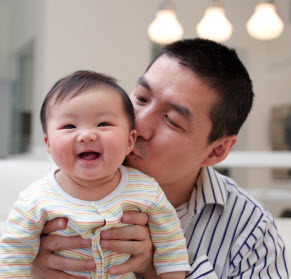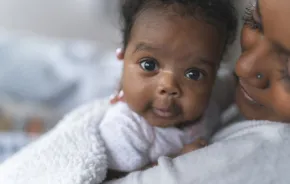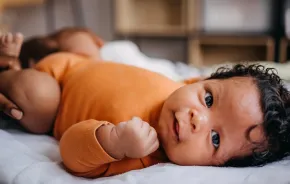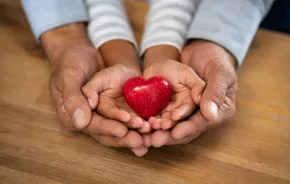 All about your 3-month-old baby!
All about your 3-month-old baby!
Physical development: Three months usually brings a growth spurt, so your baby may be hungrier. Let him eat as much as he wants, says Princess Ivana. An added bonus for breastfeeding moms: nursing burns calories, which can help you lose the baby weight more quickly. But be careful not to lose too much weight at once; feed yourself healthfully and frequently.
Brain development: Motor skills are getting stronger and with them, the brain’s architecture is growing as your baby interacts with the world. White matter, which affects the brain’s speedy processing, is growing rapidly too, laying the foundation for creative thought, says Princess Ivana.
At this age, your baby watches faces intently, follows moving objects, recognizes familiar objects and people at a distance, starts using hands and eyes in coordination, smiles at the sound of your voice, begins to babble, begins to imitate some sounds, turns head toward direction of sound, according to healthychildren.org, which is powered by the American Academy of Pediatrics.
Social development: This is the time for the laughter and coos that will warm the heart of everyone your baby comes into contact with. Your baby’s personality comes into play, and play is the way to help your baby grow, says Princess Ivana. When your baby coos, coo back. Modulate your voice and don't be afraid of acting silly.
Fun fact or milestone: Baby’s tummy time stretching and kicking may turn into partial rolls from side to back. Make sure to give your baby regular, supervised tummy time, which is important for development. If baby gets frustrated, that's absolutely normal. Don't be afraid to let him squirm a little, but always be ready to comfort and give him a different activity when he needs it.
What to watch for/common concerns: Each child develops at his own pace, but talk to your child's doctor if your 3- to-4-month-old can't support his head well; can't grasp objects; doesn't smile; doesn't react to loud sounds; or ignores new faces, says Dr. Michelle Terry of Seattle Children's Hospital.
One important thing you can do for your baby: Offer your baby toys to look at. Introduce them one at a time. Allow baby to explore and focus on each one. Use a variety of shapes, sizes and bright colors. Play tracking games by moving your face and toys back and forth. Good toys at this age include rattles, a soft doll or a picture book, says Princess Ivana.
More child development milestones:
- Baby at 1 month old
- Baby at 2 months old
- Baby at 3 months old
- Baby at 4 months old
- Baby at 5 months old
- Baby at 6 months old
- Baby at 7 months old
- Baby at 8 months old
- Baby at 9 months old
- Baby at 10 months old
- Baby at 11 months old
- Baby at 12 months old
- More baby topics











